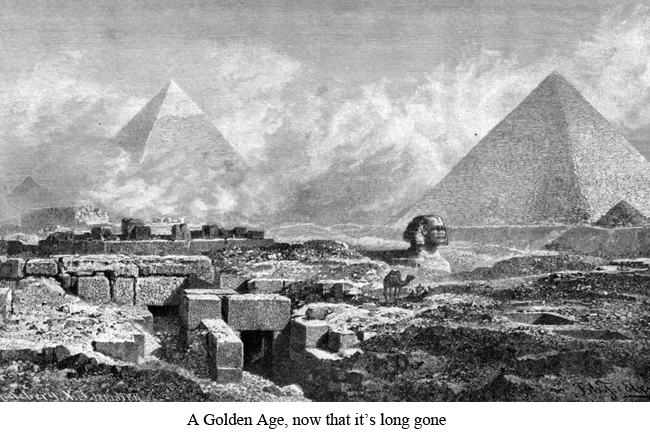Silent Revolutions
 Today, silent revolutions The University of Houston's College of Engineering presents this series about the machines that make our civilization run and about the people whose ingenuity created them.
Today, silent revolutions The University of Houston's College of Engineering presents this series about the machines that make our civilization run and about the people whose ingenuity created them.
I recently watched Woody Allen's movie, Midnight in Paris. An unfulfilled would-be American writer in Paris dreams of living in the 1920s -- running with the likes of Hemingway, Eliot, Stein, Picasso, Dali, Bunuel ... If he could only live in that Golden Age of artistic creativity he would flourish.
By some unexplained magic he's taken back into that world to meet all those luminaries. He also meets a young fashion designer. But she dreams of living in the Belle Epoque -- late 19th century up to WW-I. In a second swirl of magic, he and she find themselves transported back further yet. Now they meet Degas, Renoir, Toulouse-Lautrec ... And the message is clear enough. The present is boring. Everything great occurred in this or that past.
Well, we do experience Golden Ages. The Belle Epoque was the culmination of an era of peace. Our Civil War and the Franco-Prussian War were over. The Arts flourished in a time of prosperity. Same in the Roaring Twenties: Postwar prosperity, peace, and freedom led to a great creative upswing.
 And those eras didn't give us great arts alone. Technology and sciences always interweave with the arts. The Belle Epoque yielded the greatest leap ahead in physics that the world has ever seen -- electric field theory, statistical mechanics, then early quantum mechanics and relativity theory. It gave us the telephone, radio, airplane, automobile -- where do I stop? The Twenties gave us the quantum revolution, mature motion pictures, public electrification, huge advances in transportation. And that's only a tiny sampling.
And those eras didn't give us great arts alone. Technology and sciences always interweave with the arts. The Belle Epoque yielded the greatest leap ahead in physics that the world has ever seen -- electric field theory, statistical mechanics, then early quantum mechanics and relativity theory. It gave us the telephone, radio, airplane, automobile -- where do I stop? The Twenties gave us the quantum revolution, mature motion pictures, public electrification, huge advances in transportation. And that's only a tiny sampling.
So what past might you or I wish we could experience?
As I watched that movie, I realized that I'm old enough to look back upon my own life in a similar piece of human history. It was our '50s. Like these movie characters, like any person in any time, I had my own struggles, insecurities, and worries back then. I wished for a more perfect world. But see what took place: At its heart was a huge social revolution. We saw new ideas in music, poetry, theology, painting ... John Cage and Milton Babbitt, Allen Ginsberg and Jack Kerouac, Neo-orthodoxy, Jackson Pollock ... All turning the world upside down.
As the dust settles today, many people want that genie back in his bottle. Of course, genies don't go back into bottles. And we also saw life on earth being redirected by the sudden rise of the transistor, digital computers, and electronics in general. Medicine finally had a proper heart pump and antibiotics. Now surgery and medication began working miracles.
So I'm caught in the same trap I describe. I look at my wondrous Fifties and miss whatever revolution is afoot right now. We do that in every generation; because revolutions are invisible from within. I can only wonder what my grand-children will tell their grand-children about the miraculous dawn of the 21st century.
I'm John Lienhard at the University of Houston, where we're interested in the way inventive minds work.
I talk more about nature of the times in which the Belle Epoque, the Roaring Twenties, and the Fifties occurred, in: J. H. Lienhard, Inventing Modern: Growing up with X-Rays, Skyscrapers, and Tailfins (New York, Oxford University Press, 3003).
For more on the movie, Midnight in Paris, see the International Movie Data Base.
See also the Wikipedia entries for all of the personages I mention. Images: Advertisement of the Midnight in Paris DVD, Picasso's Stein is public domain, pyramids drawing is clipart.

This episode was first aired on May 14, 2012